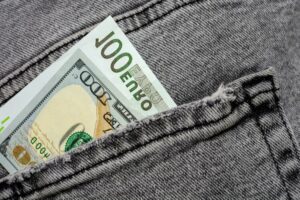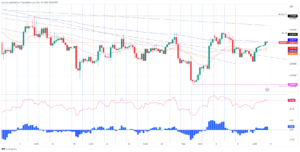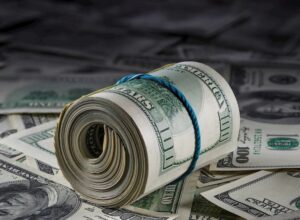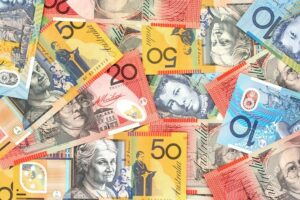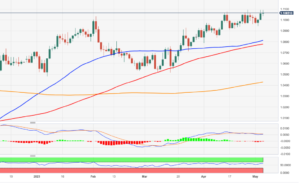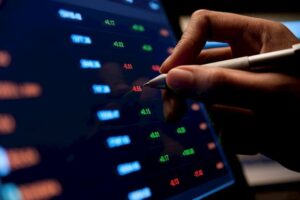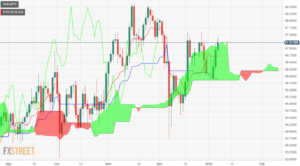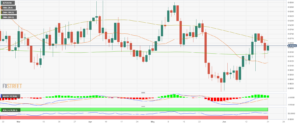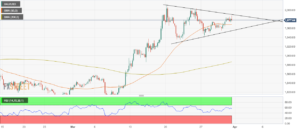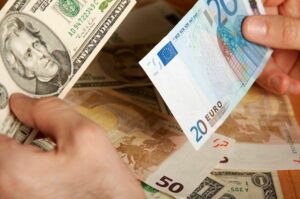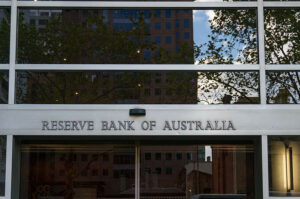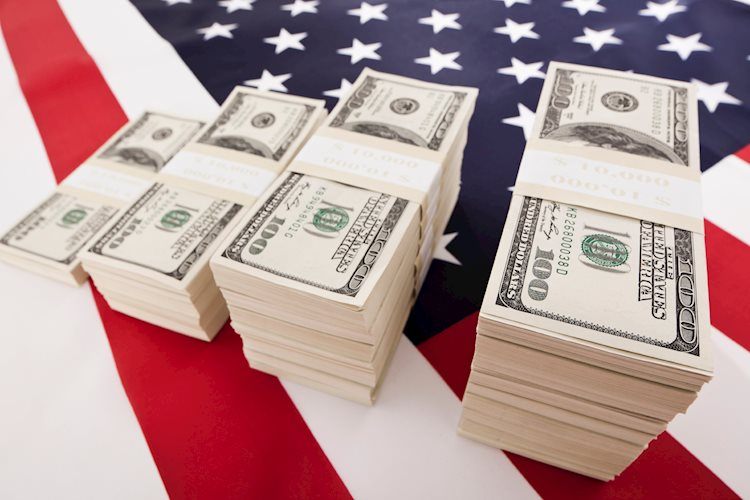
- The US Dollar trades in the green in the aftermath of the weekly US Jobless Claims.
- Traders hear Fed's Bostic call again for a steady-for-longer outlook.
- The US Dollar Index failed to close above the important technical level of 103.40.
The US Dollar (USD) trades slightly higher in the aftermath of US Jobless Claims numbers that went from 203,000 to 187,000. The upbeat number got overshadowed with another contraction print for the Philadelphia Fed Manufacturing Survey heading from -12.8 to -10.6, where -7 was expected. So some positiveness for the Greenback, though partially with that Philadelphia number dragging a touch.
On the economic front, all numbers are out of the way, though Atlanta US Federal Reserve member Raphael Bostic is due to speak again this evening near 17:05 GMT. Although he already signalled his stance earlier this morning, his last speech is the second-to-last opportunity to steer markets ahead of the blackout period starting Friday evening. A slight hawkish tilt might fuel some more US Dollar strenght on the back of his comments.
Daily digest market movers: Iran stirs tensions in the Middle East
- Houthi rebels said on Thursday that both the US and UK are now in direct conflict with the Houthi rebels.
- Iran has launched attacks on Pakistan locations. Recent numbers reveal as well that Iran has trippled its production for weapons-great Uranium.
- Thursday’s events kicked off with comments from Atlanta Federal Reserve President Raphael Bostic. He said he wants to see more evidence of inflation coming down. Wants to keep higher for longer to avoid having to cut first, and hike afterwards on a monetary policy error.
- Housing Starts data was released at 13:30 GMT, together with Jobless Claims:
- Monthly Housing Starts for December heads from 1.525 million to 1.46 million.
- Monthly Building Permits for December went from 1.46 million to 1.495 million.
- Initial Jobless Claims went from 203,000 to 187,000.
- Continuing Jobless Claims went from 1.832 million to 1.806 million.
- Philadelphia Fed Manufacturing Survey for January remained nearl unchanged at -10.6, coming from -12.8.
- The US Treasury will allocate a 4-week bill and a 10-year TIPS near 16:30 GMT and 18:00 GMT.
- Equity markets are trying to break the downbeat tone from this week. Asian indexes closed broadly flat, while European equities are trying to tie up with some small gains. US futures are dispersed with the Nasdaq in the green and the Dow Jones in the red.
- The CME Group’s FedWatch Tool shows that markets are pricing in a 97.4% chance that the Federal Reserve will keep interest rates unchanged at its January 31 meeting. Around 2.6% expect the first cut already to take place. The more traders reprice cuts to later this year, a small rate hike expectation might come through in the coming days.
- The benchmark 10-year US Treasury Note remains steady at 4.11% while the US Dollar Index has retreated a touch.
US Dollar Index Technical Analysis: Another attempt
The US Dollar Index (DXY) was unable to perform the best scenario to enter in a possible more lengthy period of Greenback strength. Although the rally could still turn into a longer uptrend, the fact that the DXY was unable to have a daily close above both the 55-day and the 200-day Simple Moving Average (SMA) at 103.40means issues ahead. The bulls can still salvage the situation this Thursday or Friday with still a close above the level, and squeeze out the final bearish elements present, before rallying further in the coming days.
The DXY is still trading near the 55-day and the 200-day Simple Moving Averages (SMA) at 103.39 and 103.45. In case the DXY can get through that area again, look for 104.44 as the first resistance level on the upside, in the form of the 100-day SMA. If that gets scattered as well, nothing will hold the DXY from heading to either 105.88 or 107.20, the high of September.
Risk of a bull trap is very much a possibility, where US Dollar bulls were caught buying into the Greenback when it broke above both the 55-day and the 200-day SMA in early Wednesday trading. Price action could decline substantially and force US Dollar bulls to sell their position at a loss. This would see the DXY first drop to 102.60, at the ascending trend line from September. Once threading below it, the downturn is open to head to 102.00.
Risk sentiment FAQs
In the world of financial jargon the two widely used terms “risk-on” and “risk off'' refer to the level of risk that investors are willing to stomach during the period referenced. In a “risk-on” market, investors are optimistic about the future and more willing to buy risky assets. In a “risk-off” market investors start to ‘play it safe’ because they are worried about the future, and therefore buy less risky assets that are more certain of bringing a return, even if it is relatively modest.
Typically, during periods of “risk-on”, stock markets will rise, most commodities – except Gold – will also gain in value, since they benefit from a positive growth outlook. The currencies of nations that are heavy commodity exporters strengthen because of increased demand, and Cryptocurrencies rise. In a “risk-off” market, Bonds go up – especially major government Bonds – Gold shines, and safe-haven currencies such as the Japanese Yen, Swiss Franc and US Dollar all benefit.
The Australian Dollar (AUD), the Canadian Dollar (CAD), the New Zealand Dollar (NZD) and minor FX like the Ruble (RUB) and the South African Rand (ZAR), all tend to rise in markets that are “risk-on”. This is because the economies of these currencies are heavily reliant on commodity exports for growth, and commodities tend to rise in price during risk-on periods. This is because investors foresee greater demand for raw materials in the future due to heightened economic activity.
The major currencies that tend to rise during periods of “risk-off” are the US Dollar (USD), the Japanese Yen (JPY) and the Swiss Franc (CHF). The US Dollar, because it is the world’s reserve currency, and because in times of crisis investors buy US government debt, which is seen as safe because the largest economy in the world is unlikely to default. The Yen, from increased demand for Japanese government bonds, because a high proportion are held by domestic investors who are unlikely to dump them – even in a crisis. The Swiss Franc, because strict Swiss banking laws offer investors enhanced capital protection.
- SEO Powered Content & PR Distribution. Get Amplified Today.
- PlatoData.Network Vertical Generative Ai. Empower Yourself. Access Here.
- PlatoAiStream. Web3 Intelligence. Knowledge Amplified. Access Here.
- PlatoESG. Carbon, CleanTech, Energy, Environment, Solar, Waste Management. Access Here.
- PlatoHealth. Biotech and Clinical Trials Intelligence. Access Here.
- Source: https://www.fxstreet.com/news/us-dollar-flattens-as-markets-test-viability-of-recent-rally-202401181230
- :has
- :is
- :where
- $UP
- 000
- 1
- 102
- 107
- 13
- 16
- 17
- 20
- 203
- 30
- 31
- 33
- 39
- 40
- 46
- 60
- 8
- 97
- a
- About
- above
- Action
- activity
- African
- aftermath
- afterwards
- again
- ahead
- All
- allocate
- already
- also
- Although
- analysis
- and
- Animate
- Another
- ARE
- AREA
- around
- AS
- asian
- Assets
- At
- Atlanta
- Attacks
- AUD
- Australian
- Australian dollar
- average
- avoid
- back
- Banking
- bearish
- because
- before
- below
- Benchmark
- benefit
- BEST
- Bill
- Bonds
- both
- Break
- Bringing
- broadly
- Broke
- Building
- bull
- bull trap
- Bulls
- buy
- Buying
- by
- CAD
- call
- CAN
- Can Get
- Canadian
- Canadian Dollar
- capital
- case
- caught
- certain
- Chance
- chf
- claims
- Close
- closed
- CME
- come
- coming
- comments
- Commodities
- commodity
- conflict
- content
- contraction
- could
- crisis
- cryptocurrencies
- currencies
- Currency
- Cut
- cuts
- daily
- data
- Days
- Debt
- December
- Decline
- Default
- Demand
- Digest
- direct
- dispersed
- Dollar
- dollar index
- Domestic
- dow
- Dow Jones
- down
- DOWNTURN
- Drop
- due
- dump
- during
- Dxy
- Earlier
- Early
- Economic
- economies
- economy
- either
- elements
- ends
- enhanced
- Enter
- Equities
- error
- especially
- Ether (ETH)
- European
- European equities
- Even
- evening
- events
- evidence
- Except
- expanded
- expect
- expectation
- expected
- exports
- fact
- Failed
- FAQ
- Fed
- Fed rates
- Federal
- federal reserve
- final
- financial
- First
- flat
- For
- Force
- foresee
- form
- Franc
- Friday
- from
- front
- Fuel
- further
- future
- Futures
- FX
- Gain
- Gains
- get
- GMT
- Go
- Gold
- got
- Government
- government bonds
- greater
- Green
- Greenback
- Group’s
- Growth
- Have
- having
- Hawkish
- he
- head
- Heading
- hear
- heavily
- heavy
- heightened
- Held
- High
- higher
- Hike
- his
- hold
- housing
- HTTPS
- if
- important
- in
- increased
- index
- indexes
- inflation
- interest
- Interest Rates
- into
- Investors
- Iran
- issues
- IT
- ITS
- January
- Japanese
- Japanese Yen
- jargon
- jobless claims
- jones
- jpg
- JPY
- Keep
- largest
- Last
- later
- launched
- Laws
- less
- Level
- like
- Line
- locations
- longer
- Look
- loss
- major
- manufacturing
- Market
- Markets
- materials
- meeting
- member
- Middle
- might
- million
- minor
- modest
- module
- Monetary
- Monetary Policy
- more
- morning
- most
- Movers
- moving
- moving average
- moving averages
- much
- Nasdaq
- Nations
- Near
- New
- New Zealand
- note
- nothing
- now
- number
- numbers
- NZD
- of
- off
- offer
- on
- once
- open
- Opportunity
- Optimistic
- or
- out
- Outlook
- Pakistan
- perform
- period
- periods
- permits
- philadelphia
- Place
- plato
- Plato Data Intelligence
- PlatoData
- policy
- position
- positions
- positive
- possibility
- possible
- present
- price
- PRICE ACTION
- pricing
- Production
- proportion
- protection
- rally
- rallying
- rand
- Rate
- Rate Hike
- Rates
- Raw
- recent
- Red
- refer
- relatively
- remained
- remaining
- remains
- Reserve
- Reserve Currency
- Resistance
- return
- reveal
- Rise
- Risk
- Risky
- ruble
- s
- safe
- Said
- scattered
- scenario
- see
- seen
- sell
- sentiment
- September
- shines
- Shows
- Simple
- since
- situation
- SMA
- small
- So
- some
- South
- South African
- south african rand
- speak
- speech
- Squeeze
- stance
- start
- Starting
- starts
- steady
- steer
- Still
- Stirs
- stock
- Stock markets
- strength
- Strengthen
- strict
- substantially
- such
- Survey
- Swiss
- Take
- Technical
- Technical Analysis
- tend
- tensions
- terms
- that
- The
- The Future
- The Weekly
- the world
- their
- Them
- therefore
- These
- they
- this
- this week
- this year
- though?
- Through
- thursday
- TIE
- times
- tips
- to
- together
- TONE
- tool
- touch
- Traders
- trades
- Trading
- treasury
- Trend
- trying
- TURN
- two
- Uk
- unable
- unlikely
- upbeat
- Upside
- uptrend
- us
- US Dollar
- US Dollar Index
- US Federal
- us federal reserve
- us futures
- us government
- US Jobless Claims
- US Treasury
- USD
- used
- value
- very
- wants
- was
- Way..
- Wednesday
- week
- weekly
- WELL
- went
- were
- when
- which
- while
- WHO
- widely
- will
- willing
- with
- world
- world’s
- worried
- would
- year
- Yen
- Zealand
- zephyrnet

